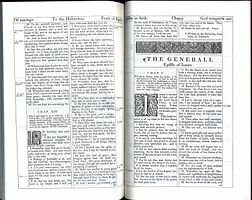 The Epistle to the Hebrews (abbr. Heb for citations) is a very consciously "literary" document in the New Testament. The purity of its Greek was noted by Clement of Alexandria, according to Eusebius of Caesarea (Historia Eccl., VI, xiv), and Origen asserted that every competent judge must recognize a great difference between this epistle and Paul's (Eusebius, VI, xxv).
The Epistle to the Hebrews (abbr. Heb for citations) is a very consciously "literary" document in the New Testament. The purity of its Greek was noted by Clement of Alexandria, according to Eusebius of Caesarea (Historia Eccl., VI, xiv), and Origen asserted that every competent judge must recognize a great difference between this epistle and Paul's (Eusebius, VI, xxv).The letter has carried its traditional title since Tertullian described it as Barnabae titulus ad Hebraeos in De Pudicitia chapter 20 ("Barnabas's Letter to the Hebrews".)
This letter consists of two strands:
- an expositional or doctrinal strand:
(Hebrews 1:1–14; 2:5–18; 5:1–14; 6:13–9:28; 13:18–25), - an hortatory or ethical strand which punctuates the exposition parenthetically at key points as warnings to the readers:
(Hebrews 2:1–4; 3:1–4:16; 6:1–12; 10:1–13:17)
Hebrews does not fit the form of a traditional Hellenistic epistle, lacking a proper closing and prescript. Modern scholars generally believe this book was originally a sermon or homily, although possibly modified after it was delivered to include the travel plans, greetings and closing (13:20-25).
More...


No comments:
Post a Comment